
In the context of the WTO and its predecessor the GATT, the trade and environment linkage was first made in the early 1970’s. With the increased attention paid to environmental protection in many parts of the world, as reflected in the 1972 Stockholm Conference on the Human Environment, the GATT responded with a focus not on the impact of trade on the environment, but rather the implications of environmental policies on trade. This perspective was echoed during the Tokyo Round of Trade Negotiations (1973-79). With the exception of some unsuccessful work conducted on the question of controlling the export of products prohibited domestically on the grounds of health and the environment, the GATT largely continued to neglect the question of how trade rules and policies might impact the environment and environmental policy-making. It was not until the two Tuna-Dolphin reports, which found that measures to protect dolphins from getting trapped and dying in nets during tuna harvesting were not GATT compliant, that international attention was drawn to the imp act that trade rules can have on domestic environmental policies. Surely the attention given to these two reports (although not adopted) contributed to the process, which led to the creation of the Committee on Trade and Environment (CTE) at the end of the Uruguay Round in 1994.
